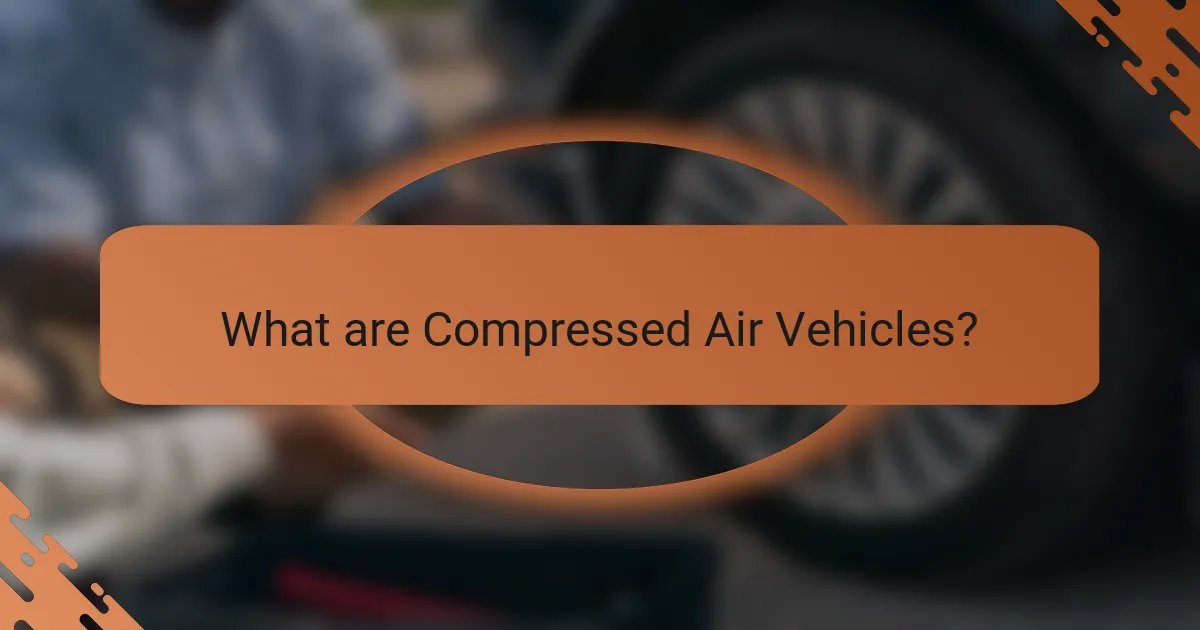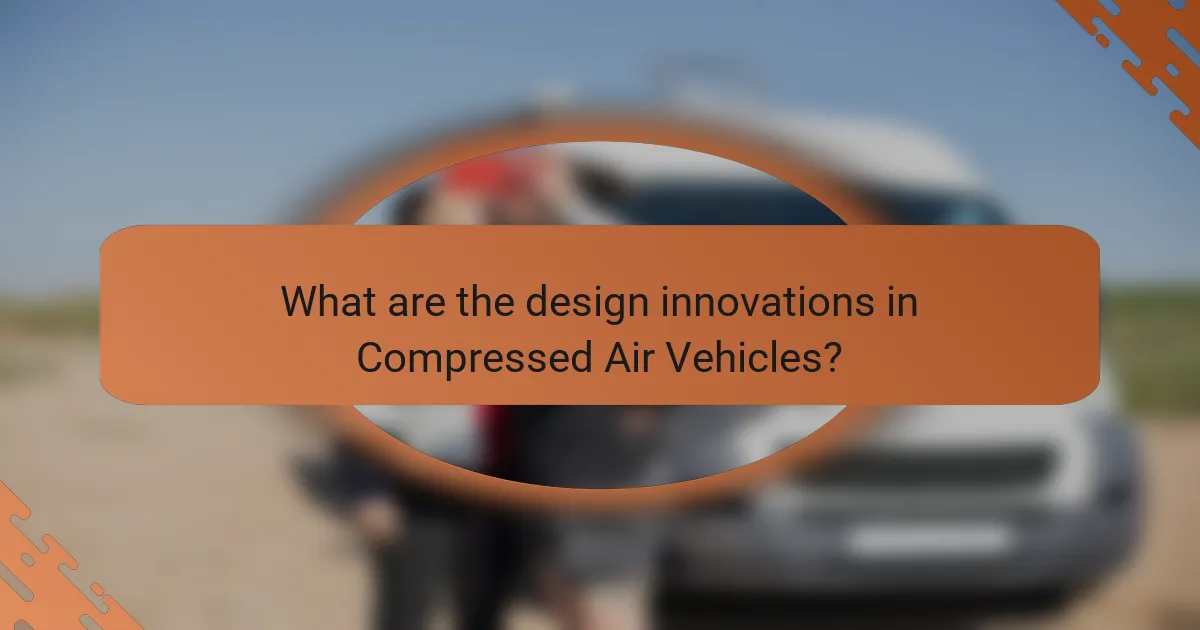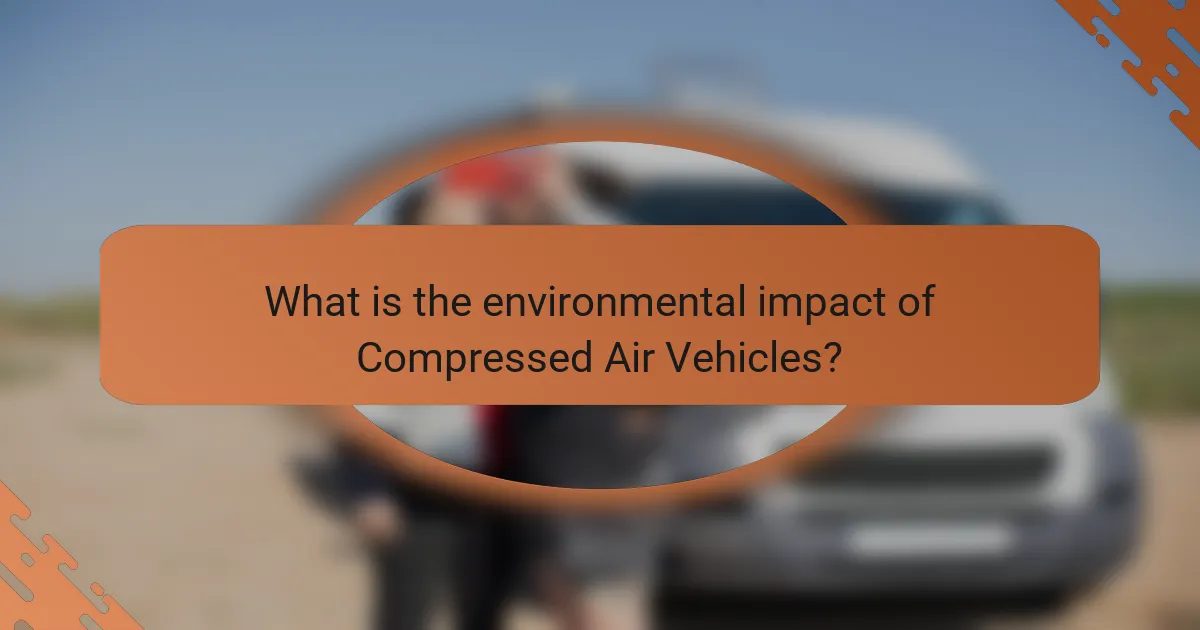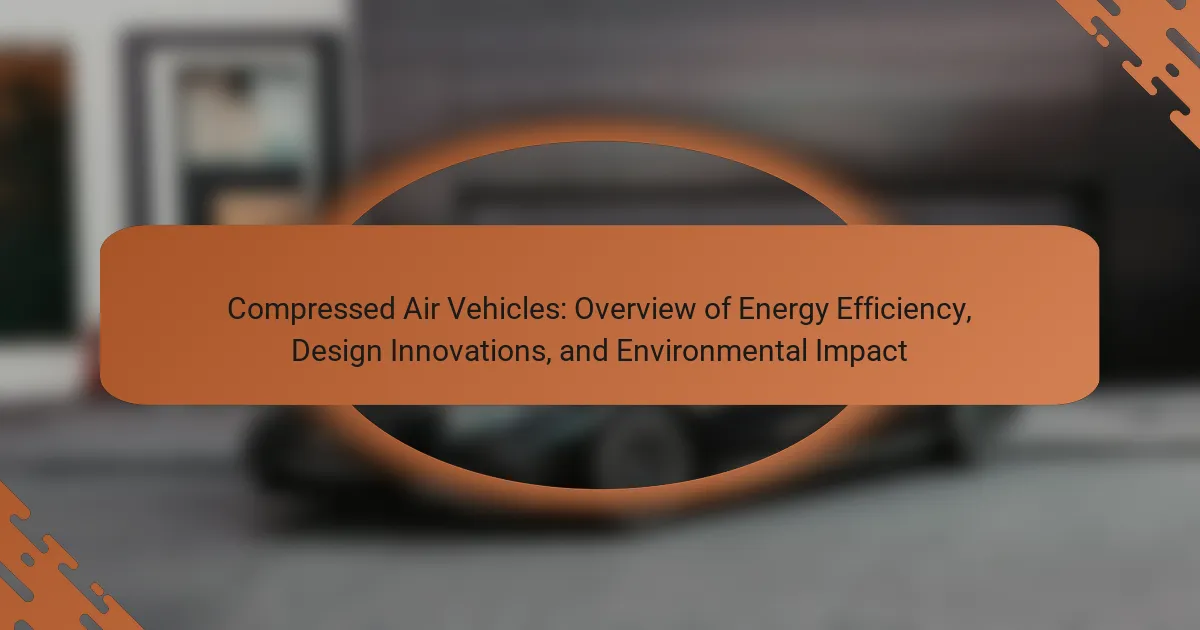Compressed Air Vehicles (CAVs) are powered by compressed air, utilizing stored air to drive pistons or turbines for mechanical power. This technology aims to reduce fossil fuel dependency and lower emissions, as CAVs produce zero tailpipe emissions, making them environmentally friendly. Innovations in design include lightweight materials, advanced air storage systems, and efficient propulsion mechanisms, enhancing performance and sustainability. Additionally, CAVs contribute to reduced urban noise pollution and can be powered by renewable energy sources, further supporting their role in sustainable transportation. The article provides an overview of the energy efficiency, design innovations, and environmental impact of compressed air vehicles.

What are Compressed Air Vehicles?
Compressed air vehicles are vehicles powered by compressed air as a source of energy. These vehicles utilize compressed air stored in tanks to drive pistons or turbines, converting the energy into mechanical power. The technology aims to reduce reliance on fossil fuels and decrease emissions. Compressed air vehicles are often considered environmentally friendly due to their zero tailpipe emissions. Various prototypes have been developed, showcasing their potential for urban transport. Research indicates that compressed air can be an efficient energy storage method. The concept has been explored by companies like Motor Development International and others.
How do Compressed Air Vehicles operate?
Compressed air vehicles operate using compressed air as their primary energy source. These vehicles store air in high-pressure tanks. When the vehicle is in operation, the compressed air is released through a motor. This release of air drives pistons or turbines, converting air pressure into mechanical energy. The mechanical energy propels the vehicle forward. Compressed air systems can be refilled at specialized stations. This method of propulsion produces zero emissions during operation. Studies show that compressed air technology can reduce reliance on fossil fuels.
What are the key components of a Compressed Air Vehicle?
The key components of a Compressed Air Vehicle include the air storage tank, air motor, and control system. The air storage tank holds compressed air at high pressure. This tank is typically made from lightweight materials to enhance vehicle efficiency. The air motor converts the energy from compressed air into mechanical energy to drive the vehicle. The control system manages the flow of air from the tank to the motor. Additionally, the vehicle may include a regenerative braking system to recharge the air tank. Together, these components enable the vehicle to operate efficiently and reduce environmental impact.
How does the compression process work in these vehicles?
The compression process in compressed air vehicles involves storing air at high pressure. This process begins with an air compressor that draws in ambient air. The compressor then reduces the volume of the air, increasing its pressure. The compressed air is stored in tanks within the vehicle. When the vehicle is in operation, the compressed air is released to drive a piston or turbine. This action converts the stored energy into mechanical energy for propulsion. The efficiency of the compression process is crucial for the vehicle’s overall performance. Studies show that higher compression ratios can enhance energy storage capacity.
What are the primary advantages of Compressed Air Vehicles?
Compressed Air Vehicles (CAVs) offer several primary advantages. They produce zero tailpipe emissions, contributing to cleaner air quality. CAVs utilize compressed air as a power source, reducing reliance on fossil fuels. This leads to lower operational costs compared to traditional vehicles. CAVs have fewer moving parts, resulting in reduced maintenance requirements. Additionally, they can be refueled quickly, similar to conventional vehicles. Their lightweight design can enhance energy efficiency. Studies indicate that CAVs can achieve significant energy savings in urban environments. Overall, these advantages position CAVs as a promising alternative in sustainable transportation.
How do Compressed Air Vehicles contribute to energy efficiency?
Compressed Air Vehicles (CAVs) contribute to energy efficiency by utilizing compressed air as a power source. This method reduces reliance on fossil fuels, leading to lower greenhouse gas emissions. CAVs convert stored air energy directly into mechanical energy. This process is generally more efficient than traditional combustion engines. Studies show that CAVs can achieve significant energy savings compared to conventional vehicles. For example, CAVs can operate with an efficiency rate of around 70% in converting air energy to motion. This high efficiency translates to reduced energy consumption per mile traveled. Additionally, CAVs require less maintenance, which can further enhance their overall energy efficiency.
What are the cost benefits associated with Compressed Air Vehicles?
Compressed Air Vehicles (CAVs) offer significant cost benefits primarily through lower operational expenses. They utilize compressed air as a propulsion method, which reduces fuel costs compared to traditional gasoline or diesel vehicles. CAVs typically require less maintenance due to fewer moving parts, resulting in lower repair costs over time.
Additionally, the energy efficiency of CAVs can lead to reduced energy expenditure. Studies indicate that compressed air technology can be more efficient than internal combustion engines, translating to savings in energy consumption. CAVs can also qualify for various government incentives and subsidies aimed at promoting clean energy vehicles, further enhancing their cost-effectiveness.
In terms of infrastructure, CAVs can benefit from lower charging costs since compressed air refueling stations can be less expensive to operate than electric charging stations. Overall, the combination of lower fuel costs, reduced maintenance, and potential government incentives contributes to the financial advantages of adopting Compressed Air Vehicles.

What are the design innovations in Compressed Air Vehicles?
Design innovations in compressed air vehicles include lightweight materials, advanced air storage systems, and efficient propulsion mechanisms. Lightweight materials, such as carbon fiber, reduce overall vehicle weight and enhance energy efficiency. Advanced air storage systems utilize high-pressure tanks to maximize air capacity while minimizing space. Efficient propulsion mechanisms convert compressed air into kinetic energy with minimal loss. Additionally, regenerative braking systems capture energy during deceleration, improving overall efficiency. These innovations contribute to the vehicle’s performance, sustainability, and reduced environmental impact.
How have advancements in technology influenced Compressed Air Vehicle design?
Advancements in technology have significantly influenced Compressed Air Vehicle design. Innovations in materials have led to lighter and more durable components. For example, carbon fiber composites are now used for vehicle bodies, enhancing strength while reducing weight. Improved air storage solutions have also emerged, such as high-pressure tanks that increase energy density. These advancements allow vehicles to travel longer distances on compressed air alone.
Additionally, developments in control systems have optimized air flow and pressure management. This enhances efficiency and performance during operation. Advances in computational fluid dynamics have improved aerodynamics, resulting in better fuel economy. Smart sensors and automation have been integrated into designs for real-time monitoring and adjustments.
Overall, these technological advancements have made Compressed Air Vehicles more viable and efficient, addressing earlier limitations in design and functionality.
What materials are commonly used in the construction of Compressed Air Vehicles?
Compressed Air Vehicles are commonly constructed using lightweight materials such as aluminum and composite materials. Aluminum is favored for its strength-to-weight ratio, enhancing vehicle efficiency. Composite materials, including carbon fiber and fiberglass, provide durability and further reduce weight. Additionally, some components may use plastics for insulation and housing. These materials contribute to the overall energy efficiency of the vehicle by minimizing energy loss and maximizing performance. The use of these materials is supported by industry practices aimed at improving vehicle sustainability and reducing environmental impact.
What role does aerodynamics play in the design of these vehicles?
Aerodynamics plays a critical role in the design of compressed air vehicles. It influences the vehicle’s efficiency, stability, and speed. Streamlined shapes reduce drag, allowing for better fuel efficiency. Efficient aerodynamics can improve range by maximizing the distance traveled on a limited energy source. Vehicles designed with aerodynamics in mind often feature smooth curves and tapered shapes. These designs minimize air resistance during motion. Studies show that optimizing aerodynamics can lead to significant energy savings. For instance, reducing drag by just 10% can enhance fuel efficiency by up to 5%.
What are the challenges faced in the design of Compressed Air Vehicles?
Compressed Air Vehicles face several design challenges. One major challenge is energy efficiency. Compressed air storage is less energy-dense than traditional fuels. This leads to limited range and performance issues. Another challenge is the complexity of the vehicle’s systems. Designing efficient compressors and storage tanks requires advanced engineering. Additionally, safety concerns arise from high-pressure systems. Ensuring structural integrity under pressure is critical. There is also the challenge of material selection. Components must withstand extreme conditions while being lightweight. Finally, public acceptance and infrastructure development pose significant hurdles. These factors collectively impact the viability of Compressed Air Vehicles.
How do safety regulations impact the design process?
Safety regulations significantly influence the design process of compressed air vehicles. These regulations ensure that vehicles meet specific safety standards to protect users and the environment. Designers must incorporate features that comply with regulations, such as pressure limits and material strength.
This often leads to the selection of safer materials and construction methods. For instance, regulations may require the use of materials that can withstand high pressure without failure. Additionally, safety regulations can dictate design elements like emergency shut-off systems and stability features.
Compliance with these regulations can also affect the vehicle’s overall efficiency and performance. Designers may need to balance safety with energy efficiency, which can complicate the design process. Ultimately, safety regulations play a crucial role in shaping the final product, ensuring it is both safe for users and compliant with legal standards.
What limitations exist in current Compressed Air Vehicle designs?
Current Compressed Air Vehicle designs face several limitations. The primary limitation is energy density. Compressed air has a low energy density compared to conventional fuels. This results in shorter driving ranges. Additionally, the efficiency of converting compressed air back into mechanical energy is low. Most designs lose energy during the compression and expansion processes.
Another limitation is the infrastructure for refueling. Compressed air refueling stations are not widely available. This makes long-distance travel impractical. Furthermore, the storage tanks required for compressed air are often bulky. This adds weight and reduces overall vehicle efficiency.
Lastly, existing designs struggle with performance in extreme temperatures. Cold weather can significantly affect the efficiency of compressed air systems. These factors collectively hinder the widespread adoption of compressed air vehicles.

What is the environmental impact of Compressed Air Vehicles?
Compressed Air Vehicles (CAVs) have a low environmental impact compared to conventional vehicles. They produce zero tailpipe emissions during operation, which helps reduce air pollution. CAVs utilize compressed air as a power source, eliminating reliance on fossil fuels. This characteristic contributes to a decrease in greenhouse gas emissions. The manufacturing process of CAVs can still generate emissions, but they are generally lower than those from traditional vehicles. Additionally, CAVs can be powered by renewable energy sources, further enhancing their environmental benefits. Studies indicate that CAVs can significantly reduce urban noise pollution due to their quieter operation. Overall, the adoption of CAVs presents a promising alternative for sustainable transportation.
How do Compressed Air Vehicles compare to traditional vehicles in terms of emissions?
Compressed Air Vehicles (CAVs) produce significantly lower emissions compared to traditional vehicles. CAVs operate using compressed air as a fuel source, resulting in zero tailpipe emissions during operation. In contrast, traditional vehicles typically rely on fossil fuels, which release carbon dioxide and other pollutants into the atmosphere.
Research indicates that conventional gasoline vehicles emit approximately 4.6 metric tons of carbon dioxide per year for an average driver. In comparison, CAVs contribute to improved air quality by eliminating these harmful emissions. The use of CAVs can lead to a reduction in greenhouse gas emissions, supporting efforts to combat climate change.
Additionally, CAVs can be powered by renewable energy sources for air compression, further enhancing their environmental benefits. Overall, CAVs represent a cleaner alternative to traditional vehicles in terms of emissions.
What are the lifecycle emissions of Compressed Air Vehicles?
The lifecycle emissions of Compressed Air Vehicles (CAVs) are primarily related to the energy used in their production, operation, and end-of-life disposal. CAVs produce zero tailpipe emissions during operation. However, emissions occur during the manufacturing process and electricity generation for compressing air. Studies indicate that the lifecycle emissions can vary significantly based on the energy source used for air compression. For instance, if renewable energy is utilized, emissions can be substantially lower compared to fossil fuel-based energy sources. According to research, lifecycle emissions for CAVs can range from 30 to 50 grams of CO2 equivalent per kilometer, depending on these factors.
How do Compressed Air Vehicles affect urban air quality?
Compressed Air Vehicles (CAVs) improve urban air quality by reducing harmful emissions. They operate using compressed air, which eliminates tailpipe pollutants. Traditional vehicles emit nitrogen oxides, particulate matter, and carbon dioxide. In contrast, CAVs produce zero emissions during operation. Studies indicate that widespread adoption could significantly decrease urban air pollution levels. For example, a report by the International Council on Clean Transportation highlights potential reductions in urban smog. Improved air quality can lead to better public health outcomes, including lower respiratory issues. Therefore, CAVs represent a promising solution for enhancing urban air quality.
What potential do Compressed Air Vehicles have for sustainability?
Compressed Air Vehicles (CAVs) have significant potential for sustainability. They utilize compressed air as a primary energy source, reducing reliance on fossil fuels. This shift can lead to lower greenhouse gas emissions compared to traditional vehicles. CAVs produce zero emissions at the point of use, contributing to cleaner urban air quality. Additionally, they can be powered by renewable energy sources during the air compression process. Research indicates that CAVs can achieve high energy efficiency, with some prototypes demonstrating over 90% efficiency in energy conversion. The adoption of CAV technology could support global efforts to combat climate change and promote sustainable transportation solutions.
How can Compressed Air Vehicles contribute to reducing fossil fuel dependency?
Compressed Air Vehicles (CAVs) can significantly reduce fossil fuel dependency by utilizing compressed air as an alternative energy source. CAVs operate by storing air under pressure and using it to drive pistons or turbines for propulsion. This technology eliminates the need for gasoline or diesel, which are traditional fossil fuels.
The use of compressed air reduces greenhouse gas emissions associated with fossil fuel combustion. Studies indicate that CAVs can achieve lower emission levels compared to conventional vehicles. Additionally, CAVs can be powered by renewable energy sources during the air compression process. This further decreases reliance on fossil fuels and enhances sustainability.
Countries like France and India have been exploring CAV technology to promote cleaner transportation. Research shows that transitioning to CAVs can help achieve national energy independence and reduce pollution levels. Implementing CAVs on a large scale could lead to a substantial decrease in fossil fuel consumption globally.
What role do Compressed Air Vehicles play in the future of green transportation?
Compressed Air Vehicles (CAVs) are poised to play a significant role in the future of green transportation. They utilize compressed air as a clean energy source, producing zero emissions during operation. This technology reduces dependence on fossil fuels and lowers greenhouse gas emissions. CAVs offer an efficient alternative to traditional vehicles, with potential for lower operational costs. Research indicates that CAVs can achieve high energy efficiency, converting up to 70% of the energy stored in compressed air into usable power. Their lightweight design and simplicity contribute to reduced manufacturing impacts compared to electric or combustion vehicles. As cities seek sustainable transportation solutions, CAVs present a viable option for urban mobility.
What are some practical considerations for adopting Compressed Air Vehicles?
Compressed Air Vehicles (CAVs) require careful consideration for successful adoption. Key factors include infrastructure requirements, as specialized refueling stations are necessary. The availability of compressed air sources must be assessed for practicality. Vehicle range is limited compared to traditional vehicles, impacting usability for long trips. Energy efficiency can vary based on design and operating conditions. Maintenance needs differ from conventional vehicles, requiring knowledge of unique systems. Additionally, initial costs may be higher due to advanced technology. Consumer acceptance is crucial, influenced by awareness and perceived benefits. These considerations are essential for evaluating the feasibility of CAV adoption.
Compressed Air Vehicles (CAVs) are innovative transportation solutions powered by compressed air, offering zero tailpipe emissions and reducing reliance on fossil fuels. This article provides a comprehensive overview of CAVs, detailing their operational mechanisms, key components, and design innovations, as well as the environmental benefits they present. It also addresses the challenges faced in their design, including energy efficiency and infrastructure requirements, while highlighting the potential for sustainability and improvements in urban air quality. Additionally, the article explores cost benefits and practical considerations for adopting CAV technology in modern transportation systems.
